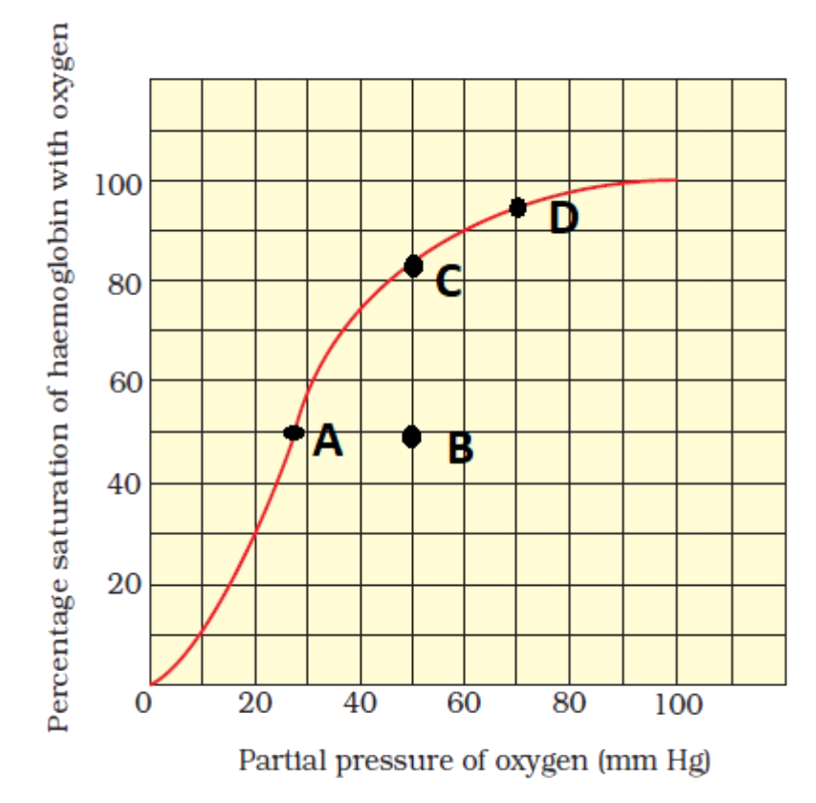Which of the following causes a leftward shift in the oxygen dissociation curve?
Increased carbon dioxide concentration
An increase in hydrogen ion concentration
A decrease in pH
All of the above
The correct Answer is:D
To determine which factors cause a leftward shift in the oxygen dissociation curve, we need to understand the relationship between hemoglobin and oxygen. The oxygen dissociation curve illustrates how hemoglobin binds with oxygen under varying conditions. A leftward shift indicates that hemoglobin has a higher affinity for oxygen, leading to more oxygen being retained in the blood and less being released to the tissues.
1. Understanding the Oxygen Dissociation Curve:
- The oxygen dissociation curve represents the saturation of hemoglobin with oxygen at different partial pressures of oxygen (PO2).
- A leftward shift in this curve indicates that hemoglobin is more saturated with oxygen at lower PO2 levels.
2. Factors Affecting the Curve:
- Several factors can influence the binding of oxygen to hemoglobin:
- Partial pressure of oxygen (PO2)
- Partial pressure of carbon dioxide (PCO2)
- Concentration of hydrogen ions (H+ ions) or pH
- Temperature
3. Identifying Leftward Shift Factors:
- A leftward shift occurs under conditions that favor the binding of oxygen to hemoglobin. These conditions include:
- High PO2: More oxygen is available for binding.
- Low PCO2: Lower carbon dioxide concentration promotes binding.
- Low H+ concentration (High pH): A higher pH favors oxygen binding.
- Low Temperature: Cooler temperatures promote oxygen retention.
4. Analyzing Given Options:
- The question asks which of the following causes a leftward shift in the oxygen dissociation curve. The options include:
- Increased carbon dioxide concentration (high PCO2)
- Increased hydrogen ion concentration (low pH)
- Decreased pH (which is equivalent to increased hydrogen ion concentration)
- All of the above
5. Conclusion:
- Increased carbon dioxide concentration and increased hydrogen ion concentration (or decreased pH) both lead to a rightward shift in the curve, indicating decreased affinity for oxygen. Therefore, they do not cause a leftward shift.
- The correct answer to the question is none of the above options cause a leftward shift. Instead, conditions that favor oxygen binding (high PO2, low PCO2, low H+, high pH, and low temperature) would cause a leftward shift.
Final Answer:
None of the provided options cause a leftward shift in the oxygen dissociation curve.
- The oxygen dissociation curve represents the saturation of hemoglobin with oxygen at different partial pressures of oxygen (PO2).
- A leftward shift in this curve indicates that hemoglobin is more saturated with oxygen at lower PO2 levels.
- Several factors can influence the binding of oxygen to hemoglobin:
- Partial pressure of oxygen (PO2)
- Partial pressure of carbon dioxide (PCO2)
- Concentration of hydrogen ions (H+ ions) or pH
- Temperature
- A leftward shift occurs under conditions that favor the binding of oxygen to hemoglobin. These conditions include:
- High PO2: More oxygen is available for binding.
- Low PCO2: Lower carbon dioxide concentration promotes binding.
- Low H+ concentration (High pH): A higher pH favors oxygen binding.
- Low Temperature: Cooler temperatures promote oxygen retention.
- The question asks which of the following causes a leftward shift in the oxygen dissociation curve. The options include:
- Increased carbon dioxide concentration (high PCO2)
- Increased hydrogen ion concentration (low pH)
- Decreased pH (which is equivalent to increased hydrogen ion concentration)
- All of the above
- Increased carbon dioxide concentration and increased hydrogen ion concentration (or decreased pH) both lead to a rightward shift in the curve, indicating decreased affinity for oxygen. Therefore, they do not cause a leftward shift.
- The correct answer to the question is none of the above options cause a leftward shift. Instead, conditions that favor oxygen binding (high PO2, low PCO2, low H+, high pH, and low temperature) would cause a leftward shift.
None of the provided options cause a leftward shift in the oxygen dissociation curve.
Similar Questions
Knowledge Check
- Question 1 - Select One
The oxygen dissociation curve is
AparabolaBslopeCsigmoidDstright line. - Question 2 - Select One
Which of the following causes biomagnification ?
ASO2BMercuryCDDTDBoth (b) and (c )
Which of the following curves is correct?
View SolutionWhich of the following is water gas shift reaction ?
View SolutionWhich of the following causes biomagnification ?
View SolutionO2 dissociation curve is:
View SolutionWhich of the following point on the oxygen dissociation curve represent p50 of HbO2 in the. graph give below ?
 View Solution
View SolutionWhich of the following is an allotrope of oxygen ?
View Solution

